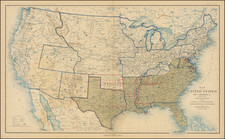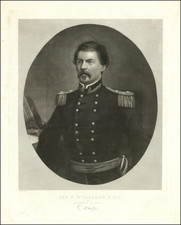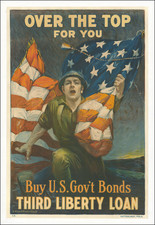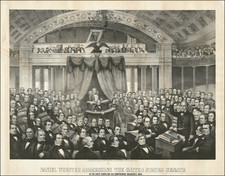Political Satire Illustrating European Intervention in Mexico
Lively illustration, with Ulysses S. Grant at the center, with a group of foreign faces watching a post-Civil War procession.
The political cartoon was probably prepared for the New-York Illustrated News or some similar publication. It was certainly published shortly after the end of the Civil War in May of 1865.
This political cartoon captures a moment of international intrigue and diplomacy, centered around the European intervention in Mexico during the 1860s. The illustration features prominent political figures of the time, including Louis Napoleon III of France and Maximilian I of Mexico, depicted with exaggerated features characteristic of the satirical style. The presence of other international figures suggests the global attention and implications of the events in Mexico. The caption, "LOUIS NAP (to Little Max.)—'You must not say nothing to 'im; zat is the man vot von ze fight,'" adds a layer of irony and commentary to the image.
The cartoon references the period of the French intervention in Mexico (1861–1867), when France, under Emperor Napoleon III, attempted to establish a monarchy in Mexico under Maximilian I, a European archduke. This intervention was part of Napoleon III's broader ambitions to expand French influence in Latin America and counterbalance the power of the United States. The cartoon reflects the complex dynamics and eventual failure of this venture, as well as the political maneuvers and relationships between the European powers and the new world entities.
In the foreground, Louis Napoleon (Napoleon III) is depicted speaking to a diminutive figure, Maximilian I, indicating the perceived power imbalance and the puppet-like status of Maximilian in this political affair. The figure to whom Napoleon refers, although not explicitly identified in the caption, is likely a representation of a Mexican republican figure or perhaps the personification of the Mexican resistance itself, which proved formidable against the French intervention.
The background is populated with various other figures, some of whom are shown in attitudes of discussion or contemplation, while others appear more active or militant. This assortment of characters may symbolize the different stakeholders and their varied interests in the Mexican conflict. The diverse attire and postures suggest a global context, touching on the different nationalities and political stances involved.
The scene is set in an ambiguous location, possibly alluding to the nebulous and far-reaching nature of the political intrigue surrounding the Mexican venture. The varied expressions and attitudes of the figures reflect the complexity and contentiousness of the situation.











![(Three Days at Gettysburg) Map of the Battlefield of Gettysburg July 1st, 2nd, 3rd 1863. . . [Three Maps]](https://storage.googleapis.com/raremaps/img/small/101769.jpg)


